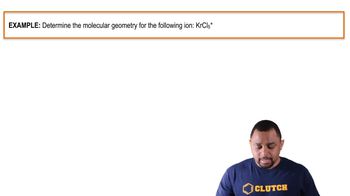Here are the essential concepts you must grasp in order to answer the question correctly.
VSEPR Theory
Valence Shell Electron Pair Repulsion (VSEPR) Theory is a model used to predict the geometry of individual molecules based on the repulsion between electron pairs in the valence shell of the central atom. According to this theory, electron pairs will arrange themselves as far apart as possible to minimize repulsion, leading to specific molecular shapes.
Recommended video:
Molecular Shapes and VSEPR
Trigonal Pyramidal Geometry
Trigonal pyramidal geometry occurs when a central atom is bonded to three other atoms and has one lone pair of electrons. This arrangement results in a pyramid-like shape with the central atom at the apex and the three bonded atoms at the base, which is characteristic of molecules like AsH3.
Recommended video:
Hybridization
Hybridization is the concept of mixing atomic orbitals to form new hybrid orbitals that can accommodate bonding. In the case of AsH3, the arsenic atom undergoes sp3 hybridization, which involves the mixing of one s orbital and three p orbitals, resulting in four equivalent sp3 hybrid orbitals that facilitate the formation of bonds with hydrogen atoms.
Recommended video:
 Verified step by step guidance
Verified step by step guidance


